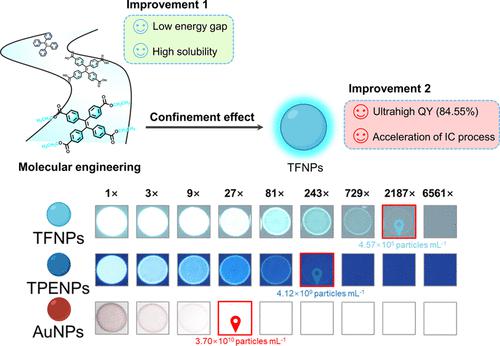Our official English website, www.x-mol.net, welcomes your
feedback! (Note: you will need to create a separate account there.)
Molecular Engineering and Confinement Effect Powered Ultrabright Nanoparticles for Improving Sensitivity of Lateral Flow Immunoassay
ACS Nano ( IF 15.8 ) Pub Date : 2024-01-05 , DOI: 10.1021/acsnano.3c10427 Gan Zhang 1 , Tingting Liu 1 , Huadong Cai 2 , Yan Hu 3 , Zhifang Zhang 4 , Meifeng Huang 2 , Juan Peng 1 , Weihua Lai 1
ACS Nano ( IF 15.8 ) Pub Date : 2024-01-05 , DOI: 10.1021/acsnano.3c10427 Gan Zhang 1 , Tingting Liu 1 , Huadong Cai 2 , Yan Hu 3 , Zhifang Zhang 4 , Meifeng Huang 2 , Juan Peng 1 , Weihua Lai 1
Affiliation

|
The application of traditional lateral flow immunoassay (LFIA)-based gold nanoparticles (AuNPs) to measure traces of target chemicals is usually challenging. In this study, we developed an integrated strategy based on molecular engineering and the spatial confinement of nanoparticles (NPs) to obtain ultrahigh quantum yields (QYs) of aggregation-induced emission (AIE) fluorescence NPs and employed them for the highly sensitive detection of T-2 toxin on the LFIA platform. Tetraethyl-4,4′,4″,4‴-(ethene-1,1,2,2-tetrayl)tetrabenzoate (TCPEME), an AIE luminogen, was designed using molecular engineering to lower the energy gap, achieving higher QYs (26.26%) than previous AIEgens (13.02%). Subsequently, TCPEME-doped fluorescence NPs (TFNPs) achieved ultrahigh QYs, up to 84.55%, which were generated from the strong restriction of the NP state, efficiently suppressing nonradiative relaxation channels verified by ultrafast electron dynamics. On the LFIA platform, the sensitivity of the designed TFNP-based LFIA (TFNP–LFIA) was 10.4-fold and 4.3-fold more sensitive than that of the AuNP–LFIA and TPENP–LFIA for detecting the T-2 toxin, respectively. In addition, TFNP–LFIA was used for detecting T-2 toxin in samples and showed satisfactory recoveries (79.5 to 122.0%) with CV (1.49 to 11.75%), which implied excellent application potential for TFNP–LFIA. Overall, dual improvement of the molecule in fluorescence performance originating from the molecular engineering and spatial confinement of NPs could be an efficient tool for promoting the development of high-performance reporters in LFIA.
中文翻译:

分子工程和限域效应驱动的超亮纳米颗粒可提高侧流免疫测定的灵敏度
应用基于传统侧流免疫分析 (LFIA) 的金纳米粒子 (AuNP) 来测量目标化学物质的痕量通常具有挑战性。在这项研究中,我们开发了一种基于分子工程和纳米颗粒(NP)空间限制的综合策略,以获得聚集诱导发射(AIE)荧光纳米颗粒的超高量子产率(QY),并将其用于高灵敏度检测T LFIA 平台上的-2 毒素。四乙基-4,4',4",4‴-(乙烯-1,1,2,2-四基)四苯甲酸酯 (TCPEME) 是一种 AIE 发光体,采用分子工程设计来降低能隙,实现更高的 QY( 26.26%)比之前的 AIEgens(13.02%)高。随后,TCPEME掺杂的荧光纳米粒子(TFNPs)实现了高达84.55%的超高QY,这是由于纳米粒子态的强限制而产生的,有效地抑制了超快电子动力学验证的非辐射弛豫通道。在 LFIA 平台上,设计的基于 TFNP 的 LFIA (TFNP-LFIA) 检测 T-2 毒素的灵敏度分别比 AuNP-LFIA 和 TPENP-LFIA 的灵敏度高 10.4 倍和 4.3 倍。此外,TFNP-LFIA用于检测样品中的T-2毒素,并显示出令人满意的回收率(79.5%至122.0%)和CV(1.49%至11.75%),这表明TFNP-LFIA具有良好的应用潜力。总体而言,源自分子工程和纳米粒子空间限制的分子荧光性能的双重改进可能是促进 LFIA 高性能报告基因发展的有效工具。
更新日期:2024-01-05
中文翻译:

分子工程和限域效应驱动的超亮纳米颗粒可提高侧流免疫测定的灵敏度
应用基于传统侧流免疫分析 (LFIA) 的金纳米粒子 (AuNP) 来测量目标化学物质的痕量通常具有挑战性。在这项研究中,我们开发了一种基于分子工程和纳米颗粒(NP)空间限制的综合策略,以获得聚集诱导发射(AIE)荧光纳米颗粒的超高量子产率(QY),并将其用于高灵敏度检测T LFIA 平台上的-2 毒素。四乙基-4,4',4",4‴-(乙烯-1,1,2,2-四基)四苯甲酸酯 (TCPEME) 是一种 AIE 发光体,采用分子工程设计来降低能隙,实现更高的 QY( 26.26%)比之前的 AIEgens(13.02%)高。随后,TCPEME掺杂的荧光纳米粒子(TFNPs)实现了高达84.55%的超高QY,这是由于纳米粒子态的强限制而产生的,有效地抑制了超快电子动力学验证的非辐射弛豫通道。在 LFIA 平台上,设计的基于 TFNP 的 LFIA (TFNP-LFIA) 检测 T-2 毒素的灵敏度分别比 AuNP-LFIA 和 TPENP-LFIA 的灵敏度高 10.4 倍和 4.3 倍。此外,TFNP-LFIA用于检测样品中的T-2毒素,并显示出令人满意的回收率(79.5%至122.0%)和CV(1.49%至11.75%),这表明TFNP-LFIA具有良好的应用潜力。总体而言,源自分子工程和纳米粒子空间限制的分子荧光性能的双重改进可能是促进 LFIA 高性能报告基因发展的有效工具。






























 京公网安备 11010802027423号
京公网安备 11010802027423号